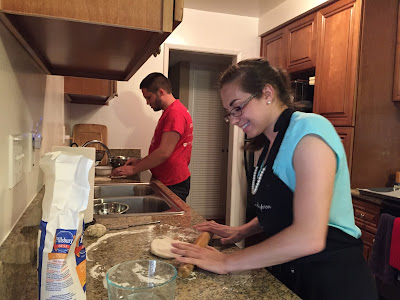Cheese Souffle'
Ingredients:
2 Tablespoons + 2 tsp. Unsalted Butter
1 Tablespoon finely grated Parmesan Cheese
2 Tablespoons All-Purpose Flour
1 cup whole milk, at room temperature
1/3 cup grated Parmesan*
1/3 cup grated Gruyere*
1/3 cup grated Sharp Cheddar*
1/4 tsp. Cayenne Pepper
1/2 tsp. Kosher Salt
3 eggs, separated
1 egg white
1/4 tsp. Cream of Tartar
Directions:
Preheat oven to 375 degrees.
Coat a 1 1/2 quart souffle' dish or baking dish with 2 tsp. butter. Dust with 1 Tablespoon of Parmesan Cheese. Store in refrigerator until ready to use.
Melt 2 Tbsp. butter in a medium saucepan. Whisk in 2 Tbsp. flour, whisking until the mixture becomes a smooth, creamy paste. Add milk and let simmer until warm, about 5 minutes. Remove from heat and stir in the Parmesan, Gruyere, Sharp Cheddar, Salt and Cayenne. Let cool slightly.
In a medium mixing bowl, whisk together the egg yolks. Quickly whisk the cheese/milk mixture into the egg yolks, a little at a time to prevent curdling. Set aside.
In a separate bowl (I highly recommend copper, if available), whisk together the four egg whites and cream of tartar until stiff glossy peaks form. In three batches, gently fold the egg whites into the cheese/milk mixture. It's ok if there are a few remaining streaks of white. You just don't want the egg whites to collapse.
Pour this into the prepared baking dish. Bake in the oven for 25 to 30 minutes, until the top is a nice golden brown. The mixture should be firm, but slightly jiggly in the center.
Bon Appetit!
* You can use any cheeses you have laying around your fridge, as long as the cheeses all amount to 1 cup; Sharp cheeses will give the most flavor.
**About 10 years ago, I attempted a lemon souffle' for dessert. I wanted it to be a surprise for my parents. So while they were gone my sister, Emily, and I began our work. Emily was going to hollow out lemons to be the souffle' cups in which we would bake our glorious desert. I could already hear the praise. Well Emily accomplished her task P-E-R-F-E-C-T-L-Y. I had already been through 2 rounds of trying to whip up egg whites which would NOT fluff up for my life! I had been beating these eggs with a hand mixer for about 45 minutes... I lost it. The kitchen counter was crowded and so I picked up the first thing I could find and flung it across the kitchen and into the living room. We heard something break. Emily stopped dead. We just looked at each other. I went to go pick it up. It was a sample size bottle of Listerine from the dentist's office (Jessica had been there earlier that day) and the cap had somehow been cracked. We wiped up the small mess and thought we'd be able to hide it from Mom and Dad. Nope. They came home and smelled the Listerine. It turns out, the Listerine somehow sprayed across the newly finished ceiling and stained it a bit too.
Yes. I got in trouble... big trouble.

















